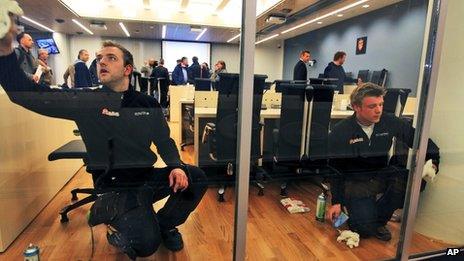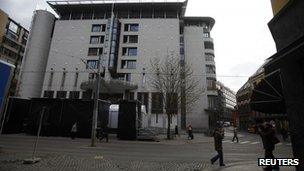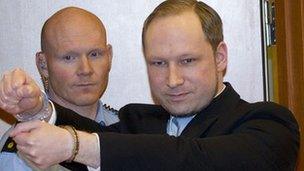Norway readies for its trial of the century
- Published

Preparations for the trial of Anders Behring Breivik have been going on since his dramatic arrest on the island of Utoeya on 22 July last year.
The terror attacks that traumatised this small nation have dominated political life and the media in Norway ever since.
Norwegians are weary of the wall-to-wall media coverage of the Breivik attacks but they are still searching for answers about what happened that day. In particular, the victims' families want to know why it took police so long to respond.
The former justice minister Knut Storberget and the former chief of security services (PST) Janne Kristiansen, both in charge at the time, were forced to resign under heavy criticism of the handling of the terror attacks.
After months of criticism, the police, the PST and Prime Minister Jens Stoltenberg finally apologised in March.
The catalogue of police errors on the day is currently under investigation and will be a main subject of the independent public inquiry into the attacks which is due to be published in August.
The Trial
Oslo District Court has built a new, custom-made courtroom (no 250) for Breivik's trial, and refurbished two floors to accommodate the media and the many aggrieved parties who will be following the trial. Geir Engebretsen, president of the court, says the trial is estimated to cost around £10m (12.1m euros; $15.9m).

The courtroom where Breivik will stand trial has been specially refurbished for this trial
He expects there to be between 1,000-1,400 people in the court building every day during the trial, however there are only 190 places available in the main courtroom which are reserved for the victims and members of the press.
An estimated 2,500 people will be able to follow the trial via video link in 18 local courts around the country.
The police have the responsibility of securing the building and have promised that everyone will feel safe. Breivik himself will be protected in court by a bulletproof screen. He has received at least two confirmed death threats in prison.
What will happen during the trial
The case will be heard by a panel of five judges rather than a jury: two professional judges and three lay judges who are general members of the public.
The trial is expected to finish on 22 June. The verdict, due some weeks later, can be appealed.
The trial will begin with the indictment read out by the prosecution. Breivik is expected to take the stand on Tuesday 17 April and will have several days to testify.
While the prosecution will call more than 90 witnesses, Breivik's lawyers will summon up to 40.
Controversially, his defence counsel has notified the court it will call a number of far right extremists including a prolific Norwegian blogger, known as Fjordman, whom Breivik quoted extensively in his manifesto.
They will also call members of the Labour Party and Progress Party, as well as writers and experts on terrorism and psychiatry. Several public figures have said they will refuse to appear.
Breivik's defence counsel Geir Lippestad has taken the unusual step of warning the nation that what his client is likely to say in court will be offensive and shocking. Breivik is proud of what he has done and has instructed his counsel to tell the press: "I am not sorry and I would do the same thing all over again."
Victims' apprehension

Breivik shot dead 69 people on the island of Utoeya, after killing eight in a bomb attack
Many of Breivik's victims hope that through this lengthy judicial process all aspects of Norway's dark Friday will be revealed and they will get the answers they need.
Bjoern Ihler, 20, who survived the massacre on Utoeya and took care of two children aged eight and nine during the ordeal, has been called to testify during the trial. He told the BBC that he was ready to face Breivik and that he had accepted he would have to live with what happened for the rest of his life. "But I don't want Norway to change because of what Breivik did; we need to get back to who we were before the 22nd of July."
Mette Yvonne Larsen, coordinating counsel for the aggrieved parties, says that the questions surrounding Breivik's sanity are key for her clients. "Most of them do not believe he is insane - they were there, they looked him in the eye, they watched him calmly walk around the island shooting."
Two major psychiatric reports ordered by the court have come up with opposite conclusions. The first report back in November (243 pages) concluded that Breivik was a paranoid schizophrenic and was psychotic at the time of the crime. The second report (319 pages), published a few days ago, concluded that Breivik was sane and showed no signs of psychosis.
The battleground of this trial
This question will be at the heart of the trial: whether Breivik is criminally insane or sane. Extraordinarily, the defence counsel agrees with the victims' families that Breivik is sane. The prosecution asserts that he is criminally insane. In criminal trials it is usually the other way around.

Breivik has already confessed to the killings
Breivik has sent a 36-page letter to members of the press criticising the forensic psychiatrists Synne Soerheim and Torgeir Husby who carried out the first report, claiming that 80% of what they wrote was made up.
He writes: "Being declared insane would be a fate worse than death." His lawyers have told the BBC that, for him, the most important aim of the trial is that the court finds him sane.
Breivik sees himself as a political activist and a soldier on a mission to save Norway and Europe from being taken over by Islam. Being declared insane would be a blow to his perceived credibility. That is why Breivik wants a prison sentence rather than a compulsory mental health care order.
The survivors and victims' families want answers and hope that at the end of the trial he will disappear from the public space to allow the healing to begin.